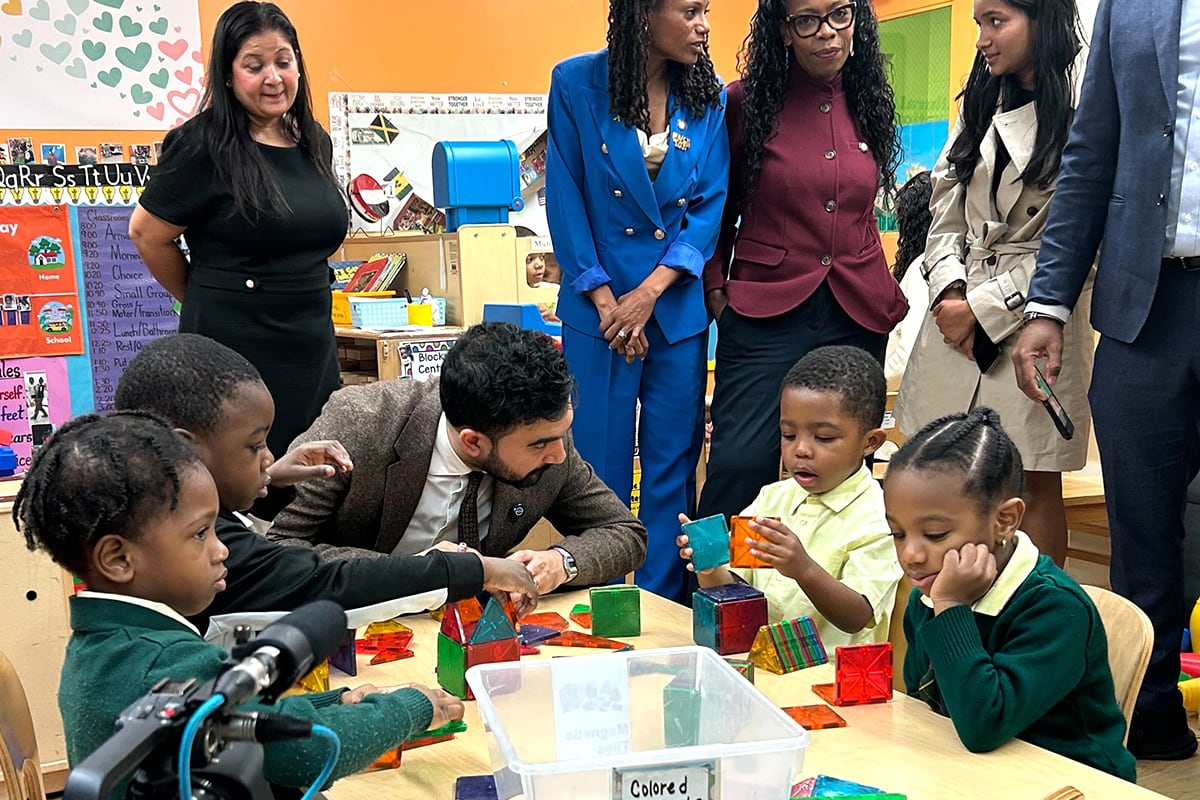Sign up for Chalkbeat New York’s free daily newsletter to get essential news about NYC’s public schools delivered to your inbox.
A Brooklyn prekindergarten classroom that Mayor-elect Zohran Mamdani visited Thursday to plug his $6 billion proposal for free universal child care bustled with activity.
More than a dozen 4-year-olds filled the small room with magnet creations, art projects, and a play bowling alley.
But one floor below, two large classrooms sat empty — as they have for the past five years.
To fulfill his ambitious and costly pledge to provide free universal child care to children 2 and under, Mamdani will have to build new seats and figure out how to make better use of the existing ones, he acknowledged Thursday.
“While so much of this conversation rightfully centers on funding, there’s also a number of issues around policy, around structure,” Mamdani said. “The city has oftentimes made it harder … today, we have two classrooms that are empty that used to be providing infant care in this very facility.”
Ever since the child care center, part of the Friends of Crown Heights network, switched from serving a mix of infants, toddlers, and preschoolers to exclusively offering city-funded pre-K and 3-K programs, it hasn’t been able to enroll enough 3- or 4-year-olds to fill the space, said Angalie Dasai, the network’s CEO.
It’s a reality that has bedeviled child care providers across the city: Even as demand for free care soars, many programs — particularly in the city’s lowest-income neighborhoods — have struggled to fill their seats.
Last year, more than 27,000 of the city’s roughly 136,000 free child care seats for kids ages 4 and under went unfilled, according to city data, or about 1 in every 5 seats.
The vacant seats are a problem at multiple levels. They force wasteful public spending, threaten the financial stability of providers, and signal that the city isn’t meeting families’ needs, experts said.
Providers, advocates, and elected officials say one logical fix is giving child care operators the flexibility to convert unused seats currently reserved for one age group to serve a different age.
For the Friends of Crown Heights program, that would mean converting the existing vacant seats for 3- and 4-year-olds into seats for infants and toddlers, Dasai said. She knows there’s demand for those seats in the neighborhood, but the center, which still has its license to serve infants and toddlers, can’t open them up.
“If you give programs the choice, if it’s more flexible,” she said, “we will fill the seats.”
In addition to shifting the age configuration of their seats, some providers have asked for more flexibility to convert seats currently funded only for the six hours and 20 minutes a day from September to June to seats that run 10 hours a day, year-round.
There are signs Mamdani is listening. Dasai said he was “receptive” when she raised the suggestion to him Thursday. And he highlighted the issue at a press conference with reporters.
“We know that the lack of flexibility sometimes between school day and extended care has also meant that there are families that are unable to get the care that they need,” Mamdani said.
Fulfilling his vision of universal child care will mean “ensuring that the government becomes a partner, as opposed to a burden or an obstacle,” he added.
Providers, advocates eye new contracts
Officials and experts cite a number of reasons for the vacant seats. Birth rates are declining, families with young children have fled the city in growing numbers since the pandemic, and some parents struggle with how to enroll.
Some providers also say the number — and types — of seats they’re funded for don’t match the demand in their neighborhood. But providers and lawmakers say the current child care contracts, which expire next year, don’t allow seat conversions.
Members of the City Council, which will be a key player in negotiating the city budgets that set Mamdani’s child care spending, are urging the city Education Department to rebid the contracts with more flexibility.
“This would allow providers to adjust the mix of infant/toddler, 3-K, and pre-K seats based on real-time community demand, enrollment trends, and local demographics,” officials wrote in a report from Council Speaker Adrienne Adams’ office released Thursday.
A spokesperson from the city Education Department declined to comment on the contracts.
Several providers said the agency recently notified them that contracts will be extended for two years, meaning they would last at least until 2028.
But one former city official said they believed that contracts could be amended to allow more flexibility for seat conversion without a full rebidding.
“It’s the low-hanging fruit,” said the former official, who requested anonymity to discuss the sensitive contract process. “It could buy time to plan for a thoughtful expansion and a new contract re-bidding.”
Michael Elsen-Rooney is a reporter for Chalkbeat New York, covering NYC public schools. Contact Michael at melsen-rooney@chalkbeat.org






